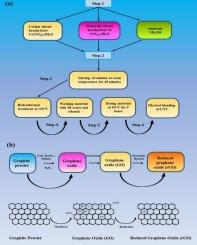研究MWCNTs和还原氧化石墨烯对混合电池-超级电容器电极材料和制氢性能的影响
IF 5.1
3区 材料科学
Q2 MATERIALS SCIENCE, COATINGS & FILMS
引用次数: 0
摘要
稀土基材料因其优异的导电性和储能性能而受到广泛关注。在这项工作中,我们研究了由氧化镍铈(NiCe2O4)、碳纳米管(CNTs)和还原氧化石墨烯(rGO)组成的纳米结构的结构和电化学行为。NiCe2O4采用水热法合成,还原氧化石墨烯采用改进的Hummer法制备。所得NiCe2O4@CNT@rGO复合电极的CV比容量为1523.5C g−1,GCD比容量为1470.6C g−1。此外,从CV和GCD测量中估计的比电容(Cs)分别为2376 F g−1和2254 F g−1。此外,利用NiCe2O4@CNT@rGO和交流电极组装了混合超级电池装置。该器件从CV和GCD分别获得166.1 Cg−1和154.8 Cg−1的Qs。该混合器件显示出令人印象深刻的能量密度(Ed)为76.4 Wkg−1,大功率密度(Pd)为1897 Wkg−1。在循环5000次后,NiCe2O4@CNT@rGO//AC系统的容量保持率为86.9%,库仑效率为94.6%。此外,NiCe2O4@CNT@rGO纳米复合电极具有优异的析氢反应(HER)活性,其过电位低至32 mV, Tafel斜率为29 mV dec−1。这些丰富的复合电极为开发先进的高性能混合储能装置开辟了广阔的前景。本文章由计算机程序翻译,如有差异,请以英文原文为准。

Study the impact of MWCNTs and rGO on nickel cerium oxide electrode material for hybrid battery-supercapacitor device and hydrogen production
Rare earth based materials have gained significant attention owing to their outstanding electrical conductivity and energy storage properties. In this work, we investigate the structural and electrochemical behavior of nanostructures composed of nickel cerium oxide (NiCe2O4), carbon nanotubes (CNTs), and reduced graphene oxide (rGO). NiCe2O4 was synthesized through a hydrothermal approach, while rGO was prepared using a modified Hummer's method. The resulting NiCe2O4@CNT@rGO composite electrode exhibited specific capacity (Qs) of 1523.5C g−1 from the CV and 1470.6C g−1 from GCD. Furthermore, the estimated specific capacitance (Cs) was 2376 F g−1 from CV and 2254 F g−1 from GCD measurements. In addition, a hybrid supercapattery device was assembled using NiCe2O4@CNT@rGO and AC electrode. This device delivered Qs of 166.1 Cg−1 from the CV and 154.8 Cg−1 from the GCD. The hybrid device demonstrated an impressive energy density (Ed) of 76.4 Whkg−1 along with a high-power density (Pd) of 1897 Wkg−1. Moreover, the NiCe2O4@CNT@rGO//AC system maintained 86.9 % capacity retention and 94.6 % Coulombic efficiency after 5000 cycles. Additionally, the NiCe2O4@CNT@rGO nanocomposite electrode exhibited excellent hydrogen evolution reaction (HER) activity, delivering a low overpotential of 32 mV and a Tafel slope of 29 mV dec−1. These earth abundant composite electrodes open up promising opportunities for the development of advanced high performance hybrid energy storage device.
求助全文
通过发布文献求助,成功后即可免费获取论文全文。
去求助
来源期刊

Diamond and Related Materials
工程技术-材料科学:综合
CiteScore
6.00
自引率
14.60%
发文量
702
审稿时长
2.1 months
期刊介绍:
DRM is a leading international journal that publishes new fundamental and applied research on all forms of diamond, the integration of diamond with other advanced materials and development of technologies exploiting diamond. The synthesis, characterization and processing of single crystal diamond, polycrystalline films, nanodiamond powders and heterostructures with other advanced materials are encouraged topics for technical and review articles. In addition to diamond, the journal publishes manuscripts on the synthesis, characterization and application of other related materials including diamond-like carbons, carbon nanotubes, graphene, and boron and carbon nitrides. Articles are sought on the chemical functionalization of diamond and related materials as well as their use in electrochemistry, energy storage and conversion, chemical and biological sensing, imaging, thermal management, photonic and quantum applications, electron emission and electronic devices.
The International Conference on Diamond and Carbon Materials has evolved into the largest and most well attended forum in the field of diamond, providing a forum to showcase the latest results in the science and technology of diamond and other carbon materials such as carbon nanotubes, graphene, and diamond-like carbon. Run annually in association with Diamond and Related Materials the conference provides junior and established researchers the opportunity to exchange the latest results ranging from fundamental physical and chemical concepts to applied research focusing on the next generation carbon-based devices.
 求助内容:
求助内容: 应助结果提醒方式:
应助结果提醒方式:


